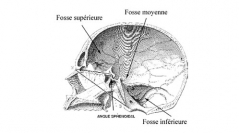

 Comptes Rendus Palevol
5 (1-2) - Pages 109-117
Comptes Rendus Palevol
5 (1-2) - Pages 109-117The chondocranium forms the base of the embryonic mammal cranium, with three cartilaginous nucleuses, the basi-ethmoid, the basi-sphenoid and the basi-occipital, all in a same alignment. They are differently aligned at birth, with a verticalization of the facial pole towards the occipital pole. The origin of this verticalization is the rotation of the basi-sphenoid, consequence of the rolling up of the underlying neural tube. The hominids and their descendants present a more important rotation than the living and fossil apes and, for the first time, is permanent from child to adult. Their apparition is inscribed in a process perceivable when one considers time at a large scale: continuous but presenting discontinuous effects.
Chondrocranium, face, sphenoid, punctuated equilibria, bipedalism, paradigm